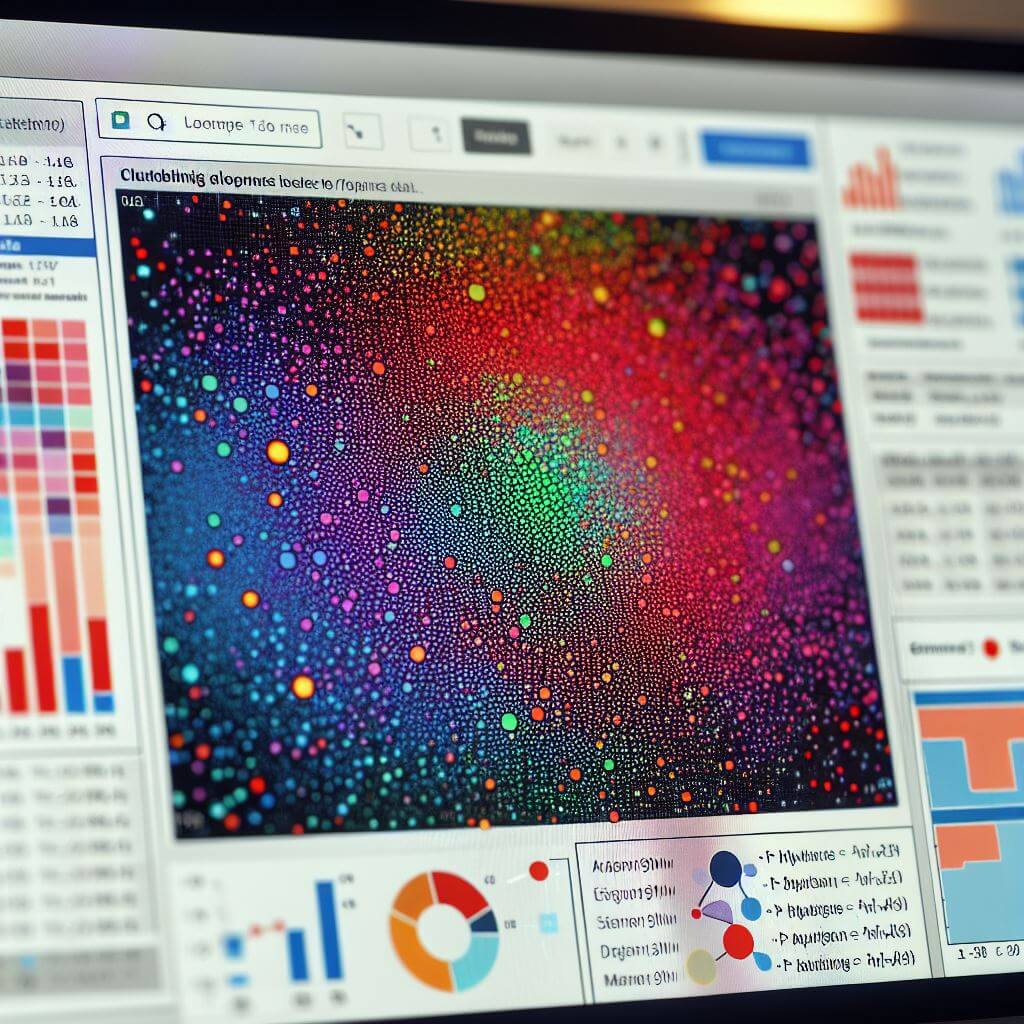Unsupervised learning represents a domain of machine learning wherein algorithms discern patterns without reference to known or labeled outcomes. One of the most prominent tools in this subfield is clustering algorithms.
Clustering algorithms create a sorting framework that groups data points based on shared features. These unsupervised learning methods are pivotal in identifying patterns without any prior training on labeled data. They invoke a natural ordering in data sets, sifting through the chaos to find structures that provide meaningful insights.
 When we dive into clustering algorithms, we encounter several core types, each with its philosophy for identifying clusters. Consider the k-means algorithm, for instance. It’s a centroid-based approach, partitioning the data into k distinct clusters based on distance from the mean point of each cluster. The k-means process iteratively adjusts the centers of each cluster until the optimal separation is achieved, minimizing the variance within each cluster. While k-means excels in speed and simplicity, it does require the number of clusters to be specified ahead of time and assumes that clusters are spherically shaped, which may not be the case for all data sets.
When we dive into clustering algorithms, we encounter several core types, each with its philosophy for identifying clusters. Consider the k-means algorithm, for instance. It’s a centroid-based approach, partitioning the data into k distinct clusters based on distance from the mean point of each cluster. The k-means process iteratively adjusts the centers of each cluster until the optimal separation is achieved, minimizing the variance within each cluster. While k-means excels in speed and simplicity, it does require the number of clusters to be specified ahead of time and assumes that clusters are spherically shaped, which may not be the case for all data sets.
In contrast to k-means, hierarchical clustering builds nested clusters by progressively merging or splitting existing groups. This technique constructs a dendrogram, a tree-like diagram that records the sequence of merges or splits, providing a detailed perspective on the data’s structure. This method is particularly useful when the relationship between data points requires a more nuanced representation than can be provided by flat clustering methods like k-means. However, hierarchical clustering can be computationally intensive, particularly with large data sets.
Density-based clustering, as seen in the DBSCAN algorithm, forms clusters based on the density of data points in a region. This technique excels in discovering clusters of arbitrary shape and in identifying outliers. Whereas partitioning and hierarchical methods may falter with unusual shapes or noise within the data, density-based clustering offers a robust alternative, capable of filtering out irrelevant data points and adapting to the data’s intrinsic patterns.
Spectral clustering takes yet another approach, using the eigenvalues of similarity matrices to reduce dimensionality before clustering in fewer dimensions. This method is adept at clustering complex, nonlinear structures which might be challenging for methods like k-means or hierarchical clustering.
Each clustering algorithm has inherent pros and cons and is suited to particular types of data and specific circumstances. Selecting the right clustering method demands an understanding of the intrinsic characteristics of the data set in question, as well as the objectives of the analysis. Hyperparameter tuning and validating cluster quality are also part of the process, using metrics such as silhouette scores or within-cluster sum squares to evaluate the cohesion and separation of the formed clusters.
Applications and Use Cases
Clustering algorithms uncover hidden patterns in data and group similar items together, forming clusters. This functionality enables them to tackle a broad spectrum of real-world problems across various industries and disciplines.
In the sphere of market segmentation, clustering helps businesses break down their customer base into more defined groups based on purchasing behavior, demographics, or preferences. By doing so, companies can tailor their marketing strategies to specific subsets of customers, optimizing resource allocation, and maximizing the efficacy of targeted advertising and product development. For instance, an e-commerce company could use clustering algorithms to identify distinct customer groups that prefer fast shipping over cost savings, allowing for more customized shopping experiences and marketing messaging
The tech industry leverages clustering in image and video analysis, commonly termed image segmentation. This is where algorithms such as k-means can help in partitioning an image into segments that consist of pixels with similar attributes, which can be particularly useful for object recognition or medical imaging where it is essential to distinguish between different types of tissue or cells. From enhancing the capabilities of autonomous vehicles to improving diagnostic procedures through better imaging analysis, clustering algorithms are making a definitive impact.
In security and fraud detection, clustering plays an instrumental role. Anomaly detection involves pinpointing data points that deviate significantly from the majority of the data, which can indicate fraudulent behavior, network intrusions, or system failures. For example, by applying clustering to transaction data, a financial institution can identify unusual patterns that signify fraudulent transactions. This application not only safeguards the financial assets of individuals and organizations but also streamlines the identification process, reducing the rate of false positives and the associated operational costs.
Another sphere where clustering algorithms shine is genomic sequencing. Advances in biotechnology have resulted in massive datasets of genetic information that require analysis. Clustering algorithms can be employed to group similar genetic sequences together, aiding in studies of evolutionary biology by identifying groups of organisms with related genetic markers. In the medical field, clustering can facilitate the discovery of relationships between genetic markers and diseases, thus contributing to personalized medicine by tailoring treatments to the genetic profiles of individual patients.
 Transportation and urban planning departments utilize clustering algorithms to optimize public transportation routes and schedules by analyzing commuter patterns. Cluster analysis can identify hotspots of transportation demand, enabling planners to reallocate resources effectively and design more efficient public transit systems that serve the needs of the community better.
Transportation and urban planning departments utilize clustering algorithms to optimize public transportation routes and schedules by analyzing commuter patterns. Cluster analysis can identify hotspots of transportation demand, enabling planners to reallocate resources effectively and design more efficient public transit systems that serve the needs of the community better.
In the realm of social networking, clustering helps to identify communities within social graphs. This enables social platforms to suggest connections, discover influencers, and offer content that aligns with the interests and behaviors of groups of users. By understanding the clustering of social connections, platforms can create more engaging and personalized user experiences.
Challenges in Clustering
While clustering has a wide array of applications across various industries, the methodologies employed are not without their challenges. These challenges can significantly impact the effectiveness of clustering algorithms and must be carefully considered and addressed by data scientists and machine learning practitioners.
Determining the Optimal Number of Clusters is one of the most formidable challenges faced when applying clustering algorithms. Many clustering algorithms, such as k-means, require a predefined number of clusters as an input. Unfortunately, there is often no clear-cut method to determine this upfront, and choosing the wrong number of clusters can lead to misleading conclusions. Techniques such as the elbow method, silhouette analysis, and cross-validation can be employed to estimate the optimal number, but each of these methods has limitations and may not be suitable for all datasets or types of clusters.
Scalability poses another significant challenge. In an era of big data where datasets can comprise millions or even billions of instances, the time complexity of traditional clustering algorithms can be prohibitive. This issue necessitates algorithms that can process large amounts of data efficiently without compromising the quality of the resulting clusters. Techniques such as dimensionality reduction or distributed computing may be used to handle large datasets, but these can introduce additional complexities and may not always be applicable.
Dealing with High-Dimensional Data can make clustering especially difficult. As the number of features or dimensions increases, distinguishing between meaningful structure and noise becomes harder—a phenomenon known as the curse of dimensionality. High-dimensional spaces can make many clustering algorithms behave erratically or inefficiently, as the notion of proximity or similarity used by most algorithms becomes less meaningful. Dimensionality reduction techniques such as PCA (Principal Component Analysis) can help, but finding the balance between simplifying data and preserving its structure is a delicate task.
Clustering Mixed Types of Data presents another layer of complexity. Real-world data is often not limited to numerical values but can include categorical, binary, and other types of data. Most standard clustering algorithms are not designed to directly handle such a mix, necessitating either pre-processing of the data to convert it into a uniform format or the development and application of specialized algorithms that can inherently manage heterogeneous data types.
Cluster Validation and Evaluation are also challenging due to the unsupervised nature of clustering. In the absence of labeled data, how does one assess the accuracy of the clusters formed? Internal indices like the silhouette score or Davies-Bouldin index can provide a measure for this, but they may not always align with human intuition or domain-specific needs for what constitutes a ‘good’ cluster.
Evaluating Results Without Ground Truth is another inherent challenge in unsupervised learning. In supervised learning, we have a ground truth to compare against, but in clustering, this is typically not the case. Consequently, determining if the clusters formed genuinely represent distinct groups in the data or are artifacts of the particular dataset or algorithm used is complicated.
Algorithm Bias and Sensitivity need attention, as some clustering algorithms can be biased toward certain cluster shapes, sizes, or densities. They might have trouble detecting clusters deviating from their assumptions, leading to suboptimal clustering results. The sensitivity of algorithms to outliers or noise can also result in distorted clusters, necessitating robust pre-processing and careful choice of clustering methods.
